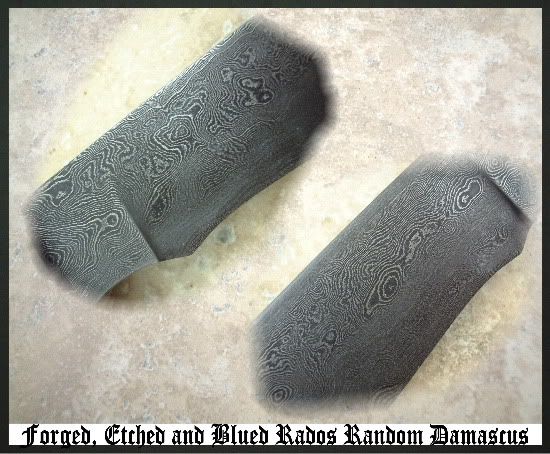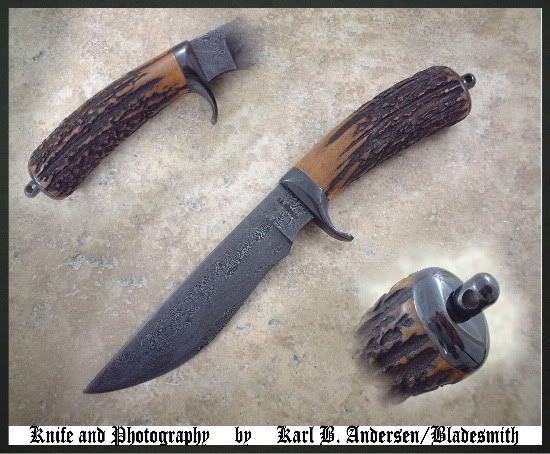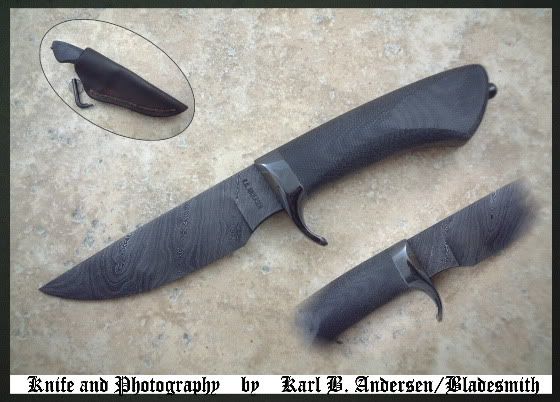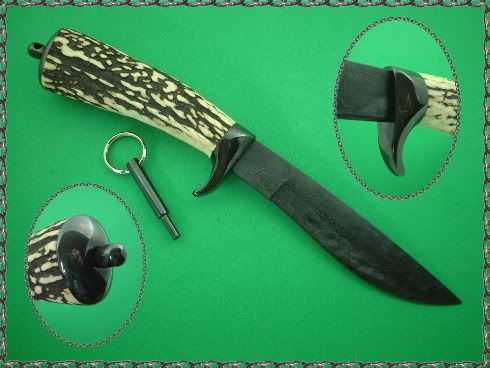Has anyone here tried hot bluing damascus that was made with A203E in it?
I'm trying to find out if hot caustic bluing will color the A203E, or if it will stay bright.
Steve - absolutely.
Jerry Rados taught me how to hot-blue more than a dozen years ago, and he's been using W2 and 203E for his Damascus since the late 1800s. <img src=' http://www.americanbladesmith.com/ipboard/public/style_emoticons//blink.gi f' class='bbc_emoticon' alt=':blink:' />
It doesn't much matter what the alloy of the steel is, the bluing is effecting the iron in the steel.
About the only thing I've discovered that won't blue with carbon steel bluing is Stainless. Yet, you can still get a bluing mixture that will do stainless and nickel as well.
203E is mostly just a mild steel with 3% nickel, I think. So it's really not much different than 15N20 except for carbon content - as far as the hot-bluing is concerned.
Hey - gotta love Photobucket!!
Here are a couple knives I made from Jerry's Damascus in maybe '02 or '03? before I had my power hammer and was making my own:
Keep in mind that it all comes out of the bluing solid black, but then I come back and sand the bluing off of the 203E/15N20 "highs".
Karl B. Andersen
Journeyman Smith
Karl,
Thanks for the information and the quick response!
I've been trading emails with a guy in Finland. He is a third year student at the Mynämäki Art and Craft Collage, in Finland. I am coaching him through his graduation project of making of a damascus gun barrel. He has asked me what is the "best" way to finish his barrel to display the pattern.
He used A203E and a Swedish high carbon steel, StenCo Leuku/W.Nr 1.1750 (C 0.75%; Si 0.3%; Mn 0.7%) to make his barrel. I've never used A203E and wasn't sure if it would color in hot bluing. I think pure nickel will not blue, so I thought maybe A203E might have enough nickel to resist bluing salts a bit.
Finishing damascus gun barrels is a unique challenge. They do not go through a full hardening and tempering, so they etch slower and do not have as much contrast as heat treated damascus. I'm still trying to figure out how best to finish my own barrels. Not sure that I'm knowledgeable enough to advise someone else how to finish their barrel, made with a different combination of steels.
Steve, I saw a W-2 and 203E Bowie knife , which was hot blued at the Blade show in Knoxville, TN in 1991. The 203E was the color of a rainbow. It was unique and beautiful. Of course you could sand the top off and it will be bright nichol color.Timothy
Tim Potier
Master Smith
I understand, Steve.
Without the etching difference creating the highs and lows and then the subsequent sanding of the bluing off of the nickel bearing steel, I'm not sure how to best expose the beauty of the barrel.
And I can see how deep etching may not be desirable on a gun barrel.
If I were you, I'd call Jerry Rados for his thoughts.
Not only has he blued train loads of his own damascus, he has done a bunch of gun bluing as well.
He may not have ever done a Damascus barrel, but Jerry thinks on his feet and has an enormous amount of experience to draw from.
(Tell him I sent ya'!)
Karl B. Andersen
Journeyman Smith
Thanks Tim and Karl,
I may give Jerry a call.
A few of the old barrels were deep etched and polished and they looked awesome. I would be okay with doing a deep etch on a barrel. But, as the barrel steel is not heat treated, it doesn't etch well in ferric chloride. Maybe it would etch better in an acid. I haven't had time to try out all of the available etchants.
Heat treating a damascus barrel tube to get it to etch better would be a challenge. The hoop stresses created on the tube in a quench may tear the barrel apart. Too, dropping a 1,500 degree tube into a liquid quench would be dangerous. The tube becomes a liquid canon, shooting the expanding liquid out the ends with a lot of force.
Most old damascus barrels were etched very lightly, or not etched at all. The materials and finishing processes used on old barrels were capable of creating a very distinct black and white finish in the damascus pattern; even when the barrel was not etched.
There is little information on the exact finishing processes used on the old barrels, 100 to 150 years ago. The few techniques and formulas that I have read, used chemicals that are hazardous . Modern gunsmiths who finish old barrels, use finishing techniques and chemicals that are different than knifemakers use on damascus knife blades. Because of the composition of the iron/steel that was used in the old barrels, they too are able to produce a black and white finish.
We do not have complete information on what iron/steels were used to make the old shotgun barrels. All of the records were destroyed in the World Wars. I am fairly confident that they used wrought iron and a low alloy medium to high carbon steel.
The challenge is to produce a black and white finish on barrels made from modern steels. I am still researching to find a combination of modern steels that will be the "best" for this type of work. It should be steels that forge weld easily, require a minimum of heat treating processes and will also finish to display the damascus pattern well. It would be grand if I could find steels that were easy to weld into a barrel and the tube could just be dropped into a hot bluing tank to create a black and white finish.
Steve, what steels do you use in the barrel?
1095 etches pretty darned black from the extra manganese over, say W1 and W2.
Karl B. Andersen
Journeyman Smith
Karl,
I used 1084 and 15N20 in my barrel. These were not my first choice of steels for a gun barrel. But early in my work to make a barrel, I was having trouble closing the welds, so I switched to steels that I knew I could get to weld. Turned out that my welding process was flawed and I have corrected that. So, I could change steels that I use for barrels now.
1084 has more manganese than 1095, so I got a decent color on the barrel. But, it's not black, like old barrels. They guys who refinish old barrels use a slow rust bluing process on them. It takes days, or weeks, to finish a barrel. I've done this type of bluing and have the chemicals in my shop to do it. Maybe I'll give that process a try next time.





